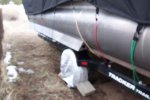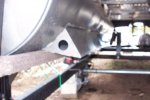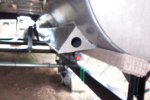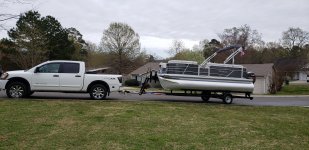Hi All, Boat is a new to me 2008 SunTracker pontoon boat with inboard and outboard lifting strakes. (I think these were referred to in the olden days as "NV Logs", not sure.)
The strakes are essentially long flattened triangles that are welded to the pontoons. They present about a 6" wide area each facing the water. The outboard ones are shorter than the inboard ones.
The front facing parts are nicely tapered and totally welded shut and one entire length along the pontoons is entirely welded shut.
BUT the other side of each strake is only 'dash' welded ( a few inches welded, a few inches not, repeat) AND the end of each strake has a clean circular hole in the end. SO, water clearly gets into the strakes as designed and installed.
? WHY? The extra weight and drag and buoyancy cancellation of all that water in the strakes would seem to offset any benefit of the strakes. Should I leave them that way and just drive the boat? Should I get some plugs and close up the 2" round holes on the end and epoxy seal the gaps in the welds? Or? Any suggestions/comments are welcome!
The strakes are essentially long flattened triangles that are welded to the pontoons. They present about a 6" wide area each facing the water. The outboard ones are shorter than the inboard ones.
The front facing parts are nicely tapered and totally welded shut and one entire length along the pontoons is entirely welded shut.
BUT the other side of each strake is only 'dash' welded ( a few inches welded, a few inches not, repeat) AND the end of each strake has a clean circular hole in the end. SO, water clearly gets into the strakes as designed and installed.
? WHY? The extra weight and drag and buoyancy cancellation of all that water in the strakes would seem to offset any benefit of the strakes. Should I leave them that way and just drive the boat? Should I get some plugs and close up the 2" round holes on the end and epoxy seal the gaps in the welds? Or? Any suggestions/comments are welcome!
























